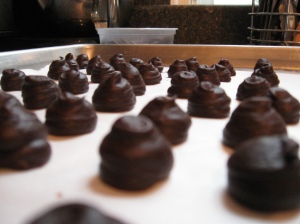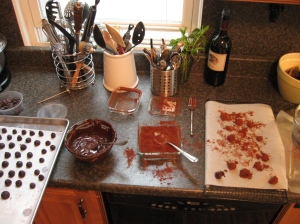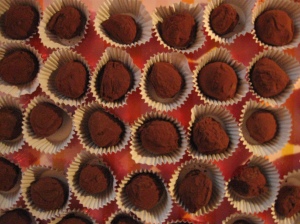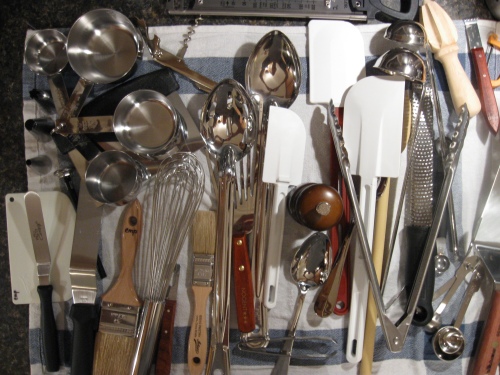Mark & I are antsy for spring. We’ve got all of our seed catalogues and spend evenings pouring over heirloom herbs and vegetables to soon be planted in our backyard. Until the 50 degree days are here to stay (and turn into 70, 80, 90 degree days after that) we’ve been working hard to keep ourselves busy through late winter weekends. Here’s a recap of two days of food and exploration both close and far from home.
Saturday at Chelsea Market
I am a little embarrassed to say, as a New Yorker, foodie and aspiring chef, that I’ve only been to Chelsea Market once, and I didn’t “get it.” That was years ago and I was a different person, so forgive me for looking right through the culinary wonderland that lives on 9th Avenue in New York City.
The space is like I imagine Pike Place, a sort of indoor mall of food and kitchen purveyors. There were lots of tourists taking pictures, which leads me to believe that the Market is listed in guidebooks. It’s a block long and houses about 15 shops, some super unique, some selling the same stuff as the guys next door.
What brought me here, and Mark, and our friends Aleka and George, was a presentation done in my and Aleka’s culinary class on a product called Nduja. Chris, who gave the presentation, was very humble and self-effacing about her history with this stuff. Her elderly great aunt smuggled it into this country on visits from Calabria before just one purveyor started to make their own in this country. Chris gave a dubious explanation as to why it can’t be imported, but like many tales of elder relatives, it was lost in translation. No worries though if you live in or near New York City.
Nduja (ahn-DOO-yah) is a spreadable pork salami whose proper production relies on 1/3 of the weight of the sausage be hot peppers, pepperoncino, in italiano. Traditionally, the pork, lots of pork fat and peppers are ground so that the emulsion is creamy and spreadable, but still chunky and recognizable as meat, fat and pepper. Its stuffed into a pig’s bladder and smoked. Once you bring it home, it has an indefinite shelf life, upwards of a year, but I dare you to make it last a week. We bought this, a hunk of fresh asiago, and peach tea from San Marzano from Buon Italia. Its on the left, about two-thirds deep into the market. Walk all the way to the back of the store and talk to the butcher.
After buying Nduja, we realized we needed bread, and Amy’s Bread, was right down the way. Its odd in this day to find a bakery that does both bread and sweets, and from the looks of the display, equally well. We passed on the chocolate ganache tarts, however and just got a baguette. A perfect crunchy crust protecting a yeasty soft core that, spread with salami and topped with a creamy slice of asiago, made for a lovely Valentine’s Day carpet picnic.
After an unremarkable lunch at Hale & Hearty Soup, we ventured into the Bowery Kitchen Supply and I could get married all over again, just to register there. The prices were perfect and the tools on sale were both practical and weird – who needs a carrot curler, anyway? They had funky knife bags from Yak Pak and if you bring your knives in on Saturdays or Wednesdays, a surly woman, perhaps of eastern European descent will sharpen them for you. I asked her what she thought it would cost for a 10″ chef’s knife that’s not in too bad shape, but could use a professional hand. “Perhaps $6. I have not seen it, but from what you told me, $6. But don’t quote me.”
Housed in the same store is L’Arte Del Gelato. Mark and I split two scoops, one of chocolate chile pepper and one of banana chocolate chip. More on this in a bit…
After filling up with freebie chocolates we left, full and happy, and thoroughly enjoyed our Valentine’s Day.
Sunday in Camden, Philadelphia and Princeton

Peasant & Shark
We didn’t exactly know how today was going to unfold, except that we made the decision to go to Adventure Aquarium before reading that President’s Day weekend was the busiest weekend of the year. Normally around this time, we throw a couple of bathing suits and our snorkeling gear into a backpack and go camping in the National Park on St. John. This year, I’m in school and jeez plane tickets have gotten expensive! So we decided that the Caribbean Currents exhibit would have to suffice for Winter ’09.
In my estimation, we were the only people there without kids. Mark claims he saw another couple who had yet to populate the earth, but there were literally thousands of families with mostly little kids, though there were some sour-looking teenagers trying not to enjoy the lucite tube through the sharks’ tank. The place smelled like baby wipes and cheerios.
Adventure Aquarium is pretty true to its name. The sign should read “ADVENTURE aquarium” and “Warning: Spongebob Squarepants will be piped into every exhibit” which he was, god love him. Who lives in a pineapple under the sea? Absorbent and yellow and porous is he!
Enough!
About the aquarium: its located in Camden, NJ which Mark described as potentially the most violent city in the US, after we took a wrong turn and the detour found us in what looked like a movie set of generic, broken down neighborhood. White Cadillac straddling the double yellow line? Check. Broken pavement littered with broken glass? Check. Eerie lack of pedestrians, and boarded up buildings surrounded by empty lots, check, check and check.
The intention of the Aquarium was to “revitalize” the Camden waterfront and is a failure at that. It’s more like they’ve built an aquarium-themed park outside of the “bad” part of town, and charge twenty bucks a head to keep the riffraff out. The displays are cute, Spongebob abounds, but they are big on adventure and small on aquarium. If you are going for science, try Boston.
By 2pm we were starving and I had googled “gastropub philadelphia” before we left Jersey City. Two promising results were returned and after looking at their websites, we had settled on the Kite & Key. I’m going to be really critical of them because its clear that they really care about their place and I want them to do just a little bit better because they are so close to being awesome.
Pros:
Extensive, eclectic beer menu
Cool laid back ambiance
Perfect price point
Cons:
The food. It wasn’t by any stretch of the imagination bad, in fact, it was really good, but it would be so easy to make some simple changes to make it great. For instance, list what comes with entrées. Maybe we are just jaded New York eaters, but when a menu doesn’t specify that a sandwich comes with fries, it means that it doesn’t. Especially when fries are listed as a side dish. We ended up with 2 orders of fries, one on Mark’s plate, next to the pulled pork sandwich, and one in a big bowl on the side. My fish tacos didn’t come with fries, and I couldn’t figure out why not.
We ordered the “cajun fries” as a side, but the seasoning was prepackaged, and was BBQ flavor – not cajun. Also, tossing the fries with the spice before plating would ensure an even coating. BUT the spicy (was it chipotle?) mayo was delicious.
Finally, avocados are cheap in the winter! Its a sin to use mass-produced guacamole in a tub when just a little extra time, and perhaps a huge savings in food cost, would mean housemade guac. Its worth the effort. If not, pull it from the menu because the store bought stuff sucks.
I loved the Kite & Key because it looks a lot like the place I hope to open someday. A couple of passionate people on a DIY budget – just fix the details and you’ll be awesome.
We departed Philly and headed, slightly out of the way, for Princeton, where we knew The Bent Spoon would revive us mid-roadtrip home. If you read Hanging Out With Farmers, you’ll know we got free samples at the NOFA conference a few weeks ago. I hadn’t forgotten the mascarpone-lavender flavor and when we got to the teeny, adorable storefront, the place was packed. It was freezing cold, yet artisan ice cream knows no temperature. Amazingly, for $7 we got four generous scoops of ice cream in two small cups. In mine, Honey and Earl Grey; in Mark’s, Coffee with Cocoa Nibs and Dark Chocolate.
How do you say heaven on a spoon? Seriously. I’m not exaggerating when I say that I would give up bad ice cream and periodically drive 40 miles to eat at The Bent Spoon. I wish I was kidding because all ice cream will forever pale in comparison. Ok, maybe not all. There’s Taylor’s in Chester, NJ. That’s many miles in the opposite direction. There’s the gelataria outside Paestum in Italy that I’ll forever remember. And the gelataria, oddly in Placencia, Belize.
Then there’s the difference between gelato and ice cream. I am planning a detailed research project. PLEASE recommend your favorite makers, who either ship or are within a day’s drive of New Jersey and I’ll report the sweet results in time for summer.
All right, I’ve chewed your ear off enough. I’m off to grill some burgers. Enjoy the long weekend and remember that all your stories are in the making. xo.











